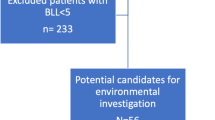Abstract
This preliminary investigation of sources of lead exposure in Moscow, Russia, by Russian and US collaborators measured lead in paint, interior dust, and drinking water in seven day-care centres, and in petrol, soil and canned food. Some paint samples exceeded US regulatory standards for lead in paint on surfaces (0.5%). Dust lead loadings were < 1.7 μg cm−2 and below the guidance levels of the US EPA. Drinking water lead concentrations were at or below the US drinking water standard of 15 μg L−1. Lead concentrations in petrol from Moscow vehicles and petrol stations were consistent with a regulation banning the sale of leaded petrol within the Moscow City limits. Except for baby food, lead levels were higher in the Russian canned foods (range 6 to 1240 μg kg−1, dry weight) compared to corresponding US canned foods, with ratios of Russian to US levels of up to 120:1 for evaporated milk. Lead concentrations in soil generally ranged from 500 to 2000 μg g−1, levels that would trigger hazard reduction measures according to US EPA guidance. These findings, together with the use of lead in petrol outside Moscow, indicate multiple sources of lead exposure in Russia. Priorities for future research are discussed including the establishment of interlaboratory quality control programmes.
Similar content being viewed by others
References
AECLP and EDF. 1994.The Global Dimensions of Lead Poisoning — an Initial Analysis. Washington DC, Alliance to End Childhood Lead Poisoning and Environmental Defense Fund.
Bond, A.M. 1983.Polarographic Methods in Analytical Chemistry. Chimiya, Moscow, pp. 289–294 (in Russian).
Central Laboratory, tState Geological Enterprise ‘Cen-trgeologia’. 1991.Report on Ecological-Geochemical Investigations of the Territory of Krasnopresnensky District in Moscow. Central Laboratory, State Geological Enterprise ‘Centrgeologia’, Moscow (in Russian).
Clark, S., Bornschein, R., Succop, P., Roda, S. and Peace, B. 1991. Urban lead exposure of children in Cincinnati, Ohio.Chemical Speciation and Bioavailability,3, 163–171.
ILO. 1927.White Lead. Studies and Report Series F, No 11, International Labor Office, Geneva.
IMGRE. 1989.Ecological-Geochemical Investigation in the Moscow Region. Institute of Minerology, Geochemistry and Crystallochemistry of Rare Elements, Moscow (in Russian).
Izmerov, N.F. 1982. Lead. In Series:Scientific Reviews of Soviet Literature on Toxicity and Hazards of Chemicals No. 42. Centre for International Projects, USSR State Committee for Science and Technology (GKNT), USSR Commission for UNEP, IRPTC, Moscow (in Russian).
Krasnopresnensky Soviet. 1990.Ecological Passport of Krasnopresnensky District of Moscow. Krasnopresnensky Soviet, Moscow (in Russian).
Ministry of Health of the Russian Federation. 1992.Atomic-Absorption Methods on Determination of Toxic Elements in Food Products and Food Raw Materials. Methodological Instructions, N 01-19/4711. MHRF, Moscow (in Russian).
MOMGE. 1984.Geochemical Mapping of Soils and Snow in Moscow by a 1 × 1 km Grid. Moscow Methodological Geochemical Expedition. Institute of Mineralogy, Geochemistry and Crystallochemistry of Rare Elements (IMGRE), Moscow (in Russian).
Murphy, E.A. 1992.Lead in School Drinking Water: Results of a Monitoring Study. New Jersey Department of Environmental Protection and Energy, New Jersey.
Needleman, H.A. 1992.Human Lead Exposure. CRC Press, Boca Raton, FL.
Novikov, M.M. 1982. Achievements in atomic absorption method of determination of metals in objects of external media.Control of Pollution of the Environment, Vol. 1Hydrometeorology. Obninsk, Moscow (in Russian).
Novikov, Y.V., Lastochkina, K.O. and Boldina, Z.N. 1990.Methods of Investigation of Quality of Water of Water Basins. 2nd Edition, Medicine, Moscow (in Russian).
Nriagu, J.O. 1979. Global inventory of natural and anthropogenic emissions of trace metals to the atmosphere.Nature (London),279, 409–411.
OECD. 1993.Risk Reduction Monograph No. 1:Lead. Organization for Economic Cooperation and Development, Environment Directorate, Paris.
Que Hee, S.S., Peace, B., Clark, C.S., Boyle, J.R., Bornschein, R.L. and Hammond, P.B. 1985. Evolution of efficient methods to sample lead sources, such as house dust and hand dust, in the homes of children.Environmental Research,38, 77–95.
Revich, B.A. and Saet, Y.E. 1990. Ecological-geochemical evaluation of the Environment of industrial cities. In:Urboecologia. Nauka, Moscow, pp. 186–197 (in Russian).
Roland, R.A. 1972.Hearings before the Subcommittee on Health of the Committee of Labor and Public Welfare, US Senate, Lead Based Paint Poisoning Amendments of 1972. US Senate transcript, March 1972, pp. 132–144.
Smith, M.A., Grant, L.D. and Sors, A.I. 1989.Lead Exposure and Child Development: An International Assessment. Kluwer Academic, Dordrecht.
Turner, J.A. (1897) Lead poisoning among Queensland children.Australian Medical Gazette 16, 475–479.
US CPSC. 1977. Lead-containing paint and certain consumer products bearing lead-containing paint, 16 CFR 1303, Consumer Product Safety Commission.Federal Register,42, 44192–44202.
US HUD. 1991.Lead-Based Paint Abatement Demonstration (FHA), HUD-0005847, Vol 1, Appendix 4. Department of Housing and Urban Development, Washington DC.
US EPA. 1989.Review of the National Ambient Air Quality Standards for Lead: Exposure Analysis Methodology and Validation. Office of Air Quality Planning and Standards Staff Report, EPA-450/2-89011. Environmental Protection Agency, Research Triangle Park, NC.
US EPA. 1991a. Maximum contaminant level goals and national primary drinking water regulations for lead and copper. Environmental Protection Agency.Federal Register,56, 26460–26564.
US EPA. 1991 b.Three City Urban Soil Lead Demonstration Project: Midterm Project Update. Environmental Protection Agency, Washington DC.
US EPA. 1994.Guidelines on Residential Lead-Based Paint, Lead Contaminated Dust and Lead-Contaminated Soil. Environmental Protection Agency, July 14, 1994. Office of Pollution Prevention and Toxic Substances, Washington DC.
US Public Law 102–550. Title X of the Housing and Community Development Act of 1992. Residential Lead-Based Paint Hazard Reduction Act of 1992, Section 401.
US Public Law 84–159. Clean Air Act (1990 Amendments), Section 211, Regulation of Fuels.
Vostal, J.J., Taves, E., Sayre, J.W. and Charney, E. 1974. Lead analysis of house dust: a method for the detection of another source of lead exposure in inner city children.Environmental Health Perspectives,7, 91–97.
Willie, S. and Berman, S. 1994.Eighth Round Intercomparison for Trace Metals in Marine Sediments and Biological Tissue. Report prepared for the Ocean Assessments Division of the US National Oceanic and Atmospheric Administration. National Research Council of Canada, Ottawa.
Ziegler, C. 1987.Environmental Policy in the USSR. University of Massachusetts Press, Massachusetts.
Author information
Authors and Affiliations
Rights and permissions
About this article
Cite this article
Orlova, A.O., Bannon, D.I., Farfel, M.R. et al. Pilot study of sources of lead exposure in Moscow, Russia. Environ Geochem Health 17, 200–210 (1995). https://doi.org/10.1007/BF00661332
Accepted:
Issue Date:
DOI: https://doi.org/10.1007/BF00661332




